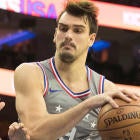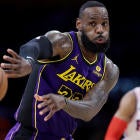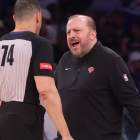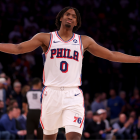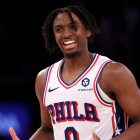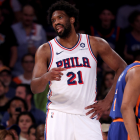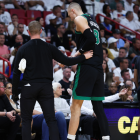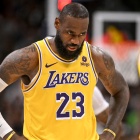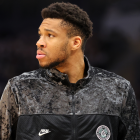Four weeks in, it feels like everything is happening at the same time. Jimmy Butler is about to make his Philadelphia 76ers debut, Carmelo Anthony is (reportedly) about to be a free agent and -- I'm sorry, I don't even want to mention this -- Caris LeVert is about to rehab another injury. Beyond all that, there are a million less obvious storylines to discuss. We'll start with how one of the recently traded Process heroes might find his mojo in Minnesota, and then we'll take a spin.
An extra life for Super Dario
Dario Saric has been a bummer this season. While he had a couple of 18-point games before the Sixers traded him to the Minnesota Timberwolves, by and large he has been limited by his role. When Markelle Fultz entered the starting lineup, Saric went from Philadelphia's third option on offense to something of a gap filler. When he grabbed rebounds, he immediately threw outlet passes to Ben Simmons or Fultz instead of pushing the ball. He rarely posted up, ran pick-and-rolls or isolated. He didn't complain publicly about his role, but his efficiency plummeted: he missed 43 of his first 56 shots from 3-point range this season, and in 13 games he shot only 30 percent from the field.
Before this season, Saric had already sacrificed for the team. In order to make room for Simmons last season, he improved his 3-point shot and accepted less playmaking responsibility. He still had his opportunities, though, and he scored 20 or more points five times in Philadelphia's 10 playoff games. When opposing teams switched against the Sixers, he could punish them in the post. His one-on-one forays toward the basket weren't always smooth, but he has the touch necessary to make hooks and flip shots that drive defenders crazy. It wasn't quite the same as his rookie year, though.
In the second half of the 2016-17 season, when Joel Embiid was sidelined and Simmons had yet to play in an NBA game, Saric was far and away Philadelphia's most talented player. Over a 25-game stretch from early February to late March, he averaged 19.2 points, 7.6 rebounds and 3.4 assists, making a compelling case for Rookie of the Year. (Malcolm Brogdon of the Milwaukee Bucks wound up winning it.) Beyond the nice numbers, Saric seemed special back then because of his unusual, unpredictable passes. He used angles most 6-foot-10 players can't see. He zipped quick passes to open shooters and found cutters when their defenders' heads were turned. His creativity, the defining element of his game, was on full display. It hasn't been since.
That version of Saric regularly saw double-teams. Once, he was quadruple-teamed. He hit face-up jumpers, he hit stepbacks, he made plays for himself and others off the dribble. Generally, good things happened when he touched the ball, and it was obvious why he was described as a point forward in pre-draft scouting reports. His play back then was so dramatically different than what we've seen recently, I would argue that nobody -- or at least nobody who receives regular minutes -- has been more marginalized. Perhaps the Minnesota Timberwolves can change that.
In Minnesota, Saric will not be the No. 1 option. On offense, Karl-Anthony Towns is the Wolves' Embiid, and Saric will be asked to continue throwing crisp entry passes. Andrew Wiggins' usage rate could rise to pre-Butler levels. Their point guards -- Jeff Teague, Derrick Rose and Tyus Jones -- are not hand-it-off-and-space-the-floor types. If coach Tom Thibodeau wants to inject some life into their attack, though, he should make sure Saric is involved. Immediately, he is Minnesota's best passer, and I want to see its offense run through him at times. I want to see him be himself.
In theory, Saric is an ideal complement for Towns and Wiggins on offense -- despite his recent slump, he can make 3s, and he is certainly capable of getting them some easy looks. The questions here are about the other end of the court and the overall ecosystem. Towns and Saric are no one's idea of a dominant defensive duo in the frontcourt. Thibodeau does not run a Sixers-esque, movement-oriented offense. Before he and his teammates get accustomed to one another, before he has even played a single game with them, I can't tell you whether or not Saric will go wild with the Wolves. All I know is, if he does, we are all the winners of this trade.
The Spin Doctor
Toronto Raptors forward Pascal Siakam -- excuse me, Eastern Conference player of the week Pascal Siakam -- has a spin move that he deploys so often, and with such effectiveness, that it deserves its own mixtape. Here is that mixtape:
I was off the mark in February when I wrote that Siakam could be special if he started making his 3-pointers. He is clearly special regardless. And hey, he went 5-for-8 from deep in his last two games.
Is New York still living in the past?
In May, the New York Knicks received plenty of praise for hiring coach David Fizdale. When he met the media, it sounded like he was going to drag the Knicks out of the stone age. He wanted them to be disruptive on defense and get in transition as much as possible. He talked about installing a free-flowing system, sharing the ball and playing positionless basketball.
Through 14 games, little of this has translated. New York is indeed forcing more turnovers, but it is 26th in defensive rating. Only Charlotte has been worse at forcing midrange shots, per Cleaning The Glass, and the Knicks give up corner 3s more frequently than anybody except Dallas, Denver and Memphis. They foul too much, they don't protect the rim well and, despite playing a lot of big lineups, they aren't particularly good at defensive rebounding.
On the other end, things are no better. New York is 26th in offensive rating, and, per Synergy Sports, it has the least efficient halfcourt offense in the league. The Knicks are 20th in pace and last in assist percentage and no team takes fewer corner 3s. They have gone from second in long 2s to seventh. Often, their best offense is missing a shot: They are fifth in offensive rebounding percentage, and they have grabbed 29.6 percent of available offensive boards when Enes Kanter, a master at this particular craft, has been on the court.
Before New York faced the Orlando Magic on Sunday, Fizdale acknowledged that, in a perfect world, the Knicks would be pushing the pace and shooting more 3s. He knows exactly what he said in the summer.
"It all sounds great when you come in, saying I want to do this and I want to do that," Fizdale said, "but you gotta work with what you have right now."
On the subject of pace, Fizdale said a lot of it is because he decided to play more two-big lineups. It is also because he doesn't want his team to be reckless. New York plays three rookies. Its best player, Kristaps Porzingis, is injured. There isn't enough shooting and there isn't even close to enough passing. Fizdale said he still emphasizes the need to get up and down the court quickly, but not at the expense of being organized.
On the subject of the assist rate, Fizdale said that the Knicks are holding the ball too much and need to develop more trust. He defended his players, though, saying that it is a matter of timing and awareness, not selfishness. He also pointed out that assists require shots to actually go in, and the Knicks haven't been particularly proficient in that area. (Counterpoint: They are second-last in potential assists, per NBA.com.)
On the subject of their 3-point rate, Fizdale said that injuries to rookie Kevin Knox and veteran Courtney Lee have had an impact. He has been forced to play to the strengths of his players, and he wants to help them succeed.
So, is Fizdale simply reckoning with the reality of a flawed roster, or is he not committed enough to a modern approach? A month into the season, I don't think there is a definitive answer. In general, I tend to think rebuilding teams should establish a style of play even when the pieces don't fit perfectly -- Kenny Atkinson has done this to great acclaim in Brooklyn over the past few years. Maybe, though, Fizdale is being selfless by trying to make his players comfortable and confident, with an understanding that he will have to take criticism from the intelligentsia in the short term.
Shortly after Fizdale's press conference, the Knicks scored 10 points in the first quarter against the Magic, who were without Aaron Gordon and Jonathan Isaac. In those 12 minutes, they had eight turnovers and failed to record an assist, a made 3 or a free throw attempt. Fizdale is not looking for sympathy, but I felt bad for him.
Gary Who?
The man who is reportedly taking a future Hall of Famer's minutes went undrafted in June and is signed to a two-way contract. He stayed in college for four years and averaged 12.9 points in his senior season. An opposing team's announcer incorrectly called him "Gary Carter" during a recent game. He is only the second most famous person named Gary Clark Jr.
It is hard to argue, however, with the idea that Clark is a snug fit as a role player for this particular Houston Rockets team. His best attribute is his defensive versatility -- he is 6-foot-8, light on his feet and strong enough to defend in the post, with quick reaction time for a rookie and all the energy in the world. He came into the league already accustomed to switching because of the way Cincinnati played; his activity level alone suggests he'd have been able to adjust anyway. A lot of young players like to compare themselves to Kevin Durant; Clark compares himself to P.J. Tucker.
"People say it's ugly," Clark said, via Jonathan Feigen the Houston Chronicle. "People have a lot of questions, why is this kid on the court and so forth. But when it comes down to winning, I do the things that a team needs. I don't always score. I won't ever complain about scoring or shots. But you'll see me getting steals, rebounds, blocking shots, getting other guys opportunity to score. All I'm about is winning."
To be clear, Clark is not Tucker. He is not Trevor Ariza or Luc Mbah a Moute, either, although Sports Illustrated's Jeremy Woo listed Mbah a Moute as his NBA comparison five months ago. Clark has only shot 12-for-40 from deep, and he's going to have to improve his accuracy if opponents are going to respect his shot in the playoffs. One positive, though, is his total buy-in to Mike D'Antoni's system: He might not be a great shooter, but he is definitely not a hesitant one.
Almost all of Clark's offense so far has come from standstill 3s. He rarely dribbles, and he is never going to ask for the ball in the mid-post. In San Antonio on Saturday, however, he shocked the Spurs by hitting LaMarcus Aldridge with a pump-fake, driving and dunking. When he and Tucker are playing power forward and center, there should be enough space for just about anybody to make a play, like Mbah a Moute learned last season. As he develops his handle, there could be more of this.
Daryl Morey's front office is understandably getting heat for many of the moves the Rockets made in the summer, but at least one decision looks like a brilliant one: calling Clark's agent as soon as the draft ended.
Turner sports better efficiency
It has been worth paying attention to Evan Turner, and I'm not just talking about the fact he's a fantastic podcast guest. This season, as the sixth man for the third-best bench in basketball, he has played his best basketball since leaving Boston.
Part of his success is related to the fact that he's shooting a ridiculous 56 percent on long 2s, per Cleaning The Glass. But Turner hasn't been doing all his damage with jumpers like this:
At 30, Turner is taking more shots at the rim than ever before (and at about twice the rate he did last season). He also has a 22.8 percent assist rate, up from 12.8 percent, once again showing that he can be one of the league's best passing wings when empowered.
Terry Stotts' coaching staff deserves credit for doing just that. Turner has played 161 minutes as the primary playmaker with Damian Lillard and CJ McCollum both on the bench; he only played without them for 59 minutes over the course of the entire 2017-18 season. The fact he has played 89 percent of his minutes with someone other than Jusuf Nurkic playing center has also helped when it comes to spacing.
One more note on Turner: Sample sizes are still small, but the Blazers have been 10.9 points per 100 possessions better on defense with him on the court than off it. I'm not sure that giant number will hold up, but he can switch across four positions.
10 more stray thoughts: Even as a longtime Montrezl Harrell believer, I am blown away by what he's doing right now … Fun seeing Tyson Chandler play meaningful minutes again … Eric Bledsoe and Malcolm Brogdon should be bigger stories but all the other positive things happening in Milwaukee are distracting … The degree to which Tony Parker in Charlotte is absolutely nothing like Patrick Ewing in Orlando or Hakeem Olajuwon in Toronto is inspiring … Tyreke Evans doesn't get enough minutes; can I change my Sixth Man of the Year pick to Julius Randle? … Comparison can't be the thief of joy because the Shai-Shaun similarities are extremely real and wonderful … Still can't believe the Wolves turned down the Josh Richardson offer … The Pistons' (lack of) spacing is upsetting ... If Carmelo actually finds his way to Philadelphia, my entire brain might explode … Free Milos Teodosic.
All statistics accurate as of games played on Nov. 12.













